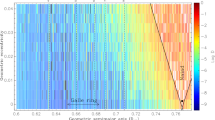Abstract
THE rings of Saturn consist of many solid particles, each revolving around Saturn as an independent satellite. Typical particle size or, more exactly, mean particle radius, ρ, has been estimated from radio interferometry and radar observations to be 2–15 cm (refs 1, 2)—consistent with a ring thickness of just over 10 m. However, the ring thickness zo as determined photometrically is at least 4 orders of magnitude greater, at 1–3 km (refs 3, 4). The generally-accepted explanation for this difference is that the particle orbits are not fully coplanar, but inclined to the mean ring plane at appreciable angles ip. However, such a model would be unstable. Indeed, particle collisions must be frequent as each particle crosses the mean plane twice for one revolution and the probability of meeting another particle is high. As a result of collisions, the energy of particle movement normal to the mean plane is dissipated, and so very soon the particle orbits must become coplanar, that is zo→2ρmax where ρmax is very likely much less than 1 km. I show here that allowing for gravitational perturbations of particle orbits by satellites and the oblateness of Saturn one may obtain a model satisfying the observational data. The main features of the model are: (1) specific wavy deformation of the rings which thus appear twisted—this is the consequence of differential precession of particle orbits with ip ≠ 0; (2) particle collisions are rare (and there is therefore only slow energy dissipation) because the neighbouring particles move in nearly the same phase.
Similar content being viewed by others
References
Briggs, F. H. Astrophys. J. 189, 367–377 (1974).
Pollack, J. B. Space Sci. Rev. 18, 3–93 (1975).
Focas, J. H., Dollfus, A. Astr. Astrophys. 2, 251–265 (1969).
Kiladze, R. I. Bull. Obs. Astrophys. Abastumani No 37, 151–163 (1969).
Palluconi, F. D. & Pettengill, G. H. (eds) The Rings of Saturn NASA SP-343, 178 (NASA, Washington, 1974).
Chebotarev, G. A. Analytical and Numerical Methods of Celestial Mechanics (Elsevier, New York, 1967).
Author information
Authors and Affiliations
Rights and permissions
About this article
Cite this article
BOBROV, M. Major satellites cause wavy deformation of Saturn's rings. Nature 273, 284–285 (1978). https://doi.org/10.1038/273284a0
Received:
Accepted:
Issue Date:
DOI: https://doi.org/10.1038/273284a0
- Springer Nature Limited
This article is cited by
-
The vertical structure and thickness of Saturn's rings
Nature (1979)





